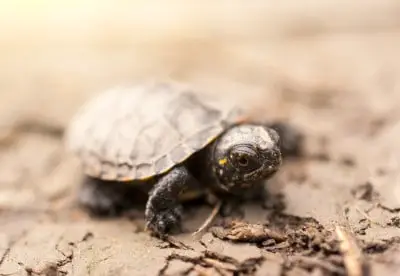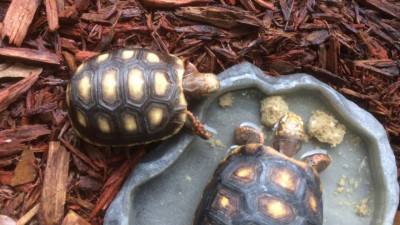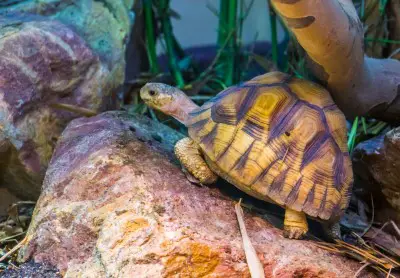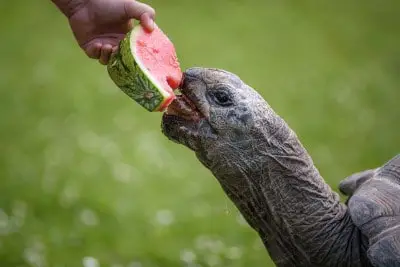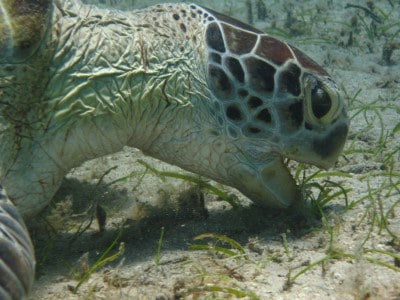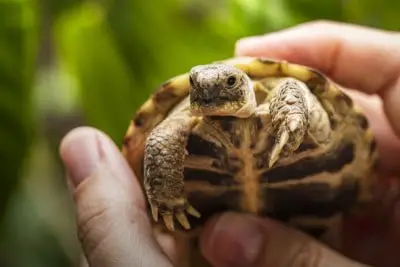A misconception among many people is that since tortoises are hardy reptiles, able to live in arid areas, they can go for long without food or water. In the same light, some owners claim that they hardly see them drinking water. As we are about to find out, their life in the wild is different from their life as pets.
Tortoises need to get regular access to clean and fresh water for the betterment of their health. However, they take water through their mouths and not the cloaca, as some people believe. Therefore, the best way to provide them water is through a clean, shallow, and wide water dish.
Just like any other pet, the tortoise entirely relies on your care to survive. That is why we give you all the information you need, whether you are a pet owner, or you are contemplating on acquiring one. Read on to find out if tortoises need water, how to provide them with water, if a tortoise can get dehydrated, and how long they can go without water.
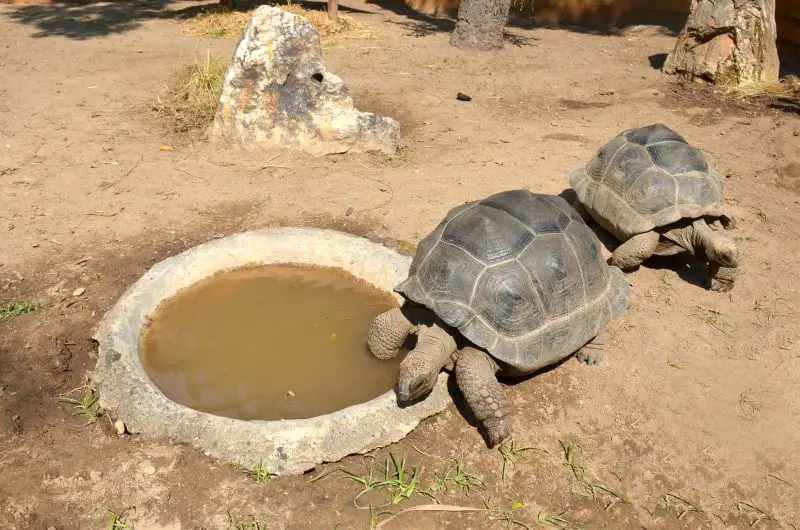
Do Tortoises Need Water?
One of a pet owner’s roles is to provide all the requirements necessary for your pet’s survival, including food and water. Despite the notion that tortoises can go for long without them, take a look at how essential water is to their well-being.
Tortoises need water to hydrate, cool down, and perform body functions such as digestion and excretion. Without it, there may be dire dehydration-related consequences that pose health issues. They can hydrate through the water you provide or food rich in water content. However, it is advisable not to substitute food with water; they still need a direct water source to hydrate. The reptiles follow their instincts when in the wild; thus, they will drink water based on their needs.
Food and water provide the tortoise with the moisture it needs. The recommended foods for hydration should contain a lot of water. If you provide cucumber, celery, and lettuce, your tortoise can gain water from them. Although these foods contain water, they are not as nutritious as other vegetables. Hence, you need to provide other nutrient-rich veggies too.
Wild tortoises are different from those in captivity. There are limited resources in their typical desert habitat, which has contributed to them going long without water. Consequently, their bodies have gradually adapted to these conditions to enable them to survive, even in semi-arid conditions. Similarly, they have devised brilliant ways to access water using every means possible. Although they are hardy, the case is different with pet tortoises; they still need frequent water replenishment.
How To Provide Water For Tortoises
It is one thing to provide water to your pet and another to get them to drink it. You may get worried that your pet will soon dehydrate, but no need to panic. There are methods you can deploy.
The most common way to provide water to your pet is by using a water dish. They drink just like humans; thus, all you need is a large clean bowl, placed at an accessible spot. To reach the surface, they will crane their necks and bow their heads. It is also common for tortoises to reject the water dish. Instead, you can use the soaking method, place them in a large container, and slowly pour water on them. They will think that it is raining; hence, they will find it easier to drink than in the wild.
Sometimes, the water bowl fails to work, and this may frustrate you. All animals follow their instincts. Thus, the water bowl concept may be unfamiliar. They may not know that you are providing drinking water. It may take some getting used to it, but once they catch on, there’s no going back. It is also essential to know that they will drink on their own when they feel the urge to hydrate. Therefore, patience is paramount in this case.
Tortoises will first reject the water in the bowl because they may think it is a drowning hazard. To counter this, ensure that the bowl is wide enough, and, if possible, it should mimic a natural water source. Therefore, avoid ceramic and plastic containers. There are better chances of them drinking if they think they are doing it from a natural water body. The dish should also be accessible enough for them to climb in and out.
Can a Turtle Get Dehydrated?
You may not have thought of the idea that tortoises can get dehydrated. The myth is that, if they can survive hot and dry climates, they are immune to thirst and dehydration. But, this is not the case, as we are about to see.
Tortoises can get dehydrated if they go for long without water. Water is particularly essential for them, as it helps to keep them hydrated and perform biological processes such as excretion. Without water, it is likely to suffer from problems such as kidney disease and gout. If these conditions worsen, the reptile’s death is inevitable. It is crucial to provide water to alleviate this and ensure that they drink it. It is also ideal for their diet to have veggies with water content; this way, they will have enough water in their system.
Signs of dehydration are readily observable. You may notice that they release a white powdery discharge (urates) from the cloaca if they are water-deprived. If well-hydrated, the secretion will be creamy. Secondly, if you press the leg, it should come back immediately; if not, your pet needs to drink more water. For a healthy tortoise, the eyes are clear, but they will appear dull and hollow if unhealthy.
Without sufficient water, your pet will suffer from severe illnesses. Dehydration will interfere with the body’s renal system, directly connected to the kidneys, and responsible for waste management. It implies that the bladder will also be affected. With uric acid buildup in the bladder, the tortoise may suffer from gout. This joint disease is usually excruciating.
Moreover, with extended dehydration, the tortoise may eventually get kidney failure. Since there is no known treatment for it, death will be imminent. The only remedy for these conditions is frequent hydration using safe and clean water.
For How Long Can Tortoises Go Without Water?
We have already established how essential water is to tortoises. Given the tortoises’ natural habitats, you may wonder how long these creatures can go without water replenishment.
If the area has low humidity levels, the longest a tortoise can go while in captivity is a week. If it goes beyond that, it will be at risk of dehydration. Thus, as a pet owner, it is vital that you provide water at least once a day, and to be safe, supplement it with a vegetable containing a lot of water. If your pet is used to drinking water daily, it may become lethargic if you go a couple of days without it. For your pet’s welfare, it is essential to do away with the notion that they are hardy, and treat them just like any other pet. With frequent hydration, its skin will be supple, eyes will be bright, and they will be generally healthy.
Frequently providing them with water does not guarantee that they are drinking enough. Improper drinking is also associated with dehydration; therefore, it is necessary to know how much is enough. Besides daily feeding, you also need to check how much the reptiles have consumed in the water bowl by comparing the current level to the initial one.
If you still feel that they are not drinking regularly, you can try placing them in a shallow bowl for some time. However, be careful not to overfill it, especially when you are dealing with baby tortoises. The water should reach their necks because they tend to panic about drowning.
If possible, you can avoid taking away the water dish; instead, top it up. It would also help to establish a routine. For instance, you can use the same bowl every day and replenishing the water at specific times; this way, the tortoises will quickly adapt. If you have made all the efforts, but they are still not drinking, it is wise to consult a vet for guidance.
Tortoises Drink Water
Food and water are critical for an animal’s survival. As much as wild tortoises can adapt to arid climates without food or water, they still have to feed at some point. Besides, over the years, their bodies have found ways to cope using the little available. However, the case with your pet should be different. As soon as they become domesticated, their needs automatically change.
Thus, to increase their lifespan and keep them happy, you need to provide food and water religiously. If your pet continues to stay for long without water, it may suffer from severe conditions such as gout and kidney failure. If not solved in time, your pet may have slim survival chances. Lastly, it is vital to check that they are drinking enough, and, if not, you can contact a vet to help.


